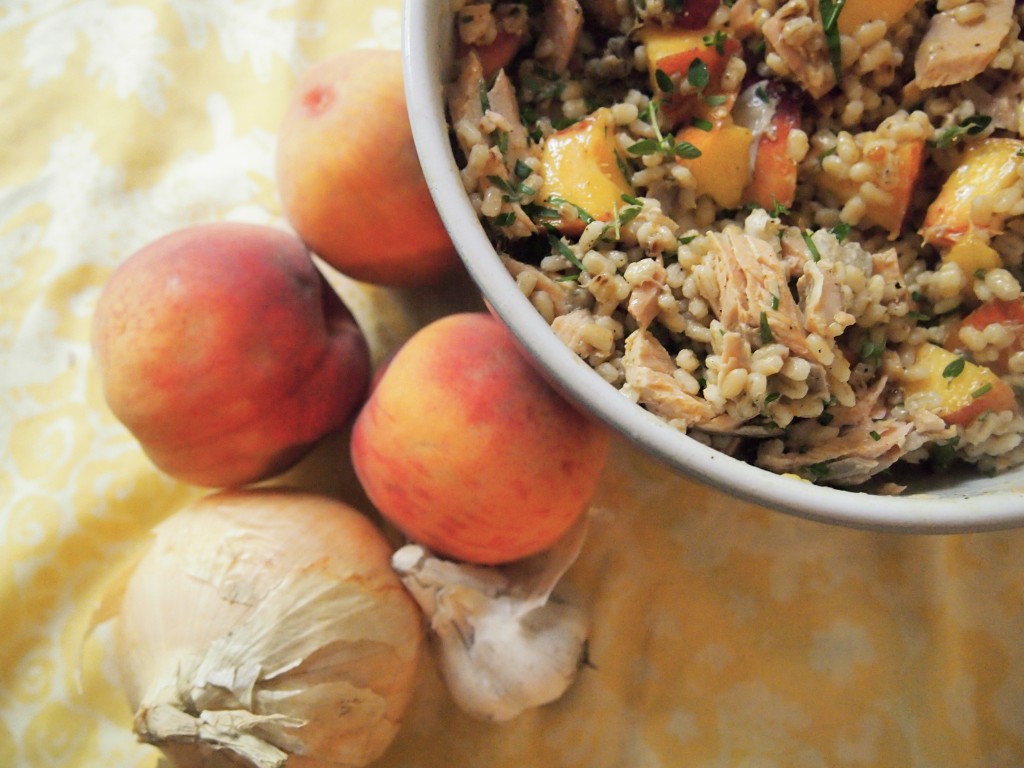
“If this is a salad, then anything is a salad,” Gary teased me last time I served this and expressly called it a salad. His taunting highlights something I’ve given idle thought to before: the definition of a salad.
Any quick search of a recipe site will prove salads are much more than beds of lettuce. I’ve seen just about any vegetable made into a salad; some of the best are completely sans lettuce, like the black bean and corn salad that graces so many picnic tables in the summer.
Nor are “salads” purely the domain of vegetables. Where would lunch be without the tuna or egg salad?
Perhaps “salad” refers to a cold temperature? But no, obviously there is hot German potato salad and wilted salads made with hot bacon dressing.
Could “salad” be a preparation technique of mixing disparate ingredients into a big pile and uniting them with a dressing? Hmmm…. mayb—- Nope. Both the casual Caprese salad of neatly overlapping mozzarella cheese slices, tomato slices, and basil leaves and the elegant towers of a sea scallop, caramelized onions, and a cornichon served in white tablecloth restaurants testify against that.
I remain at a loss. I only know that a salad is different than a casserole, which is different than a soup. And that this is surely a salad.
I used unhulled barley rather than the more common pearled barley because in addition to retaining more nutrients, I enjoy the chewiness of unhulled barley. While the long soaking step is technically optional, I strongly recommend making the time for it as your barley will cook more quickly and your body will be better able to absorb the nutrients from the grain. The added vinegar aids in the neutralization of phytic acid, a nutrient inhibitor.
Szechuan peppers are not actually related to regular peppercorns. They are members of the citrus family and hence impart an almost floral aroma and flavor. Szechuan pepper is a component of the popular Chinese Five Spice mixture. They compliment other truly spicy flavors like cayenne and chili by contributing a tingly sensation on your lips and tongue. Most bulk spice suppliers will carry them, and they are unquestionably worth trying. Though if you cannot find them, you may substitute plain black peppercorns.
Spicy Salmon Peach and Barley Salad
2 wild caught Alaskan salmon fillets about the size of a deck of cards, or two cups leftover flaked salmon
2 Tbs coconut oil (if using leftover salmon, omit this)
1 cup dry unhulled barley
2 cups chicken stock or water, plus extra if necessary
3 ripe peaches, peeled or unpeeled as you prefer
1/2 sweet onion, peeled and sliced thinly on a mandolin
2 cloves garlic, peeled and chopped
3 Tbs fruity olive oil
2 Tbs cider or rice wine vinegar
2-3 Tbs of spice mix, to taste
1/4 cup of any mixed herbs you have- I like garlic chives, thyme, basil, and oregano
Spice Mix
1 tsp smoked paprika
1 Tbs whole Szechuan peppercorns
1 Tbs whole coriander
1 tsp red chili flakes
a pinch or two of cayenne pepper (to taste)
1 Tbs salt
The night before, toast the barley in a saucepan by placing it over high heat and giving it an occasional gentle shake or stir until the toasty aroma fills your kitchen. Take it off the heat and let it cool slightly. Then add water to cover the grains by several inches. Dribble in a little vinegar and give it a stir. Cover the pan with a tea towel and let the barley soak in a warm place overnight. Whenever you’re ready to cook it the next day, drain the water and return the barley to the pan. Add the chicken stock and a generous pinch of salt. Bring to a boil, reduce the heat, and simmer covered with a tight lid for about 45 minutes. Check it a few times during cooking and replenish the liquid if necessary.
Meanwhile, in a small skillet, heat the coconut oil over medium heat until it shimmers. Add the salmon fillets skin side down and sprinkle the tops with salt and freshly ground pepper. Cover with a lid and cook until the fish flakes easily, lowering the heat if it begins to burn. Cut it into large chunks. It will be further broken up when you mix the salad together. If I can resist eating the crispy skin, I mix it with the salad as it is a source of healthy fats; if it’s texture bothers you too much, feed it to your cats. Set aside until the barley is done. If you’re using leftovers, just remove it from the fridge when you start the barley so it can come to room temperature.
Combine all your spices in a mortar and pestle or a spice mill and grind until they are powdered. Sometimes the Szechuan pepper refuses to powder completely. In this case, you can either go with it or shake it through a fine mesh colander to remove the stubborn bits.
In a large bowl, combine the warm barley, chunked salmon, garlic, onion, and peaches. Drizzle the olive oil and vinegar and sprinkle with a Tbs of the spice mixture. Mix well, preferably with your hands so you can feel when it’s all been evenly incorporated. Taste and see what you think of the spice. Add more until it suites you. Add salt and pepper to taste. Keep the leftover spice in an airtight jar in a dark cupboard for next time.
If you have time, let it sit in the fridge for a few hours so the flavors can meld. If you don’t, serve it with confidence because it will still be good. Just before serving, mix in the chopped herbs. This salad is good cold or at room temperature. I like serving it on a bed of wilted greens.
Posted 12 years, 9 months ago at 2:55 pm. 1 comment
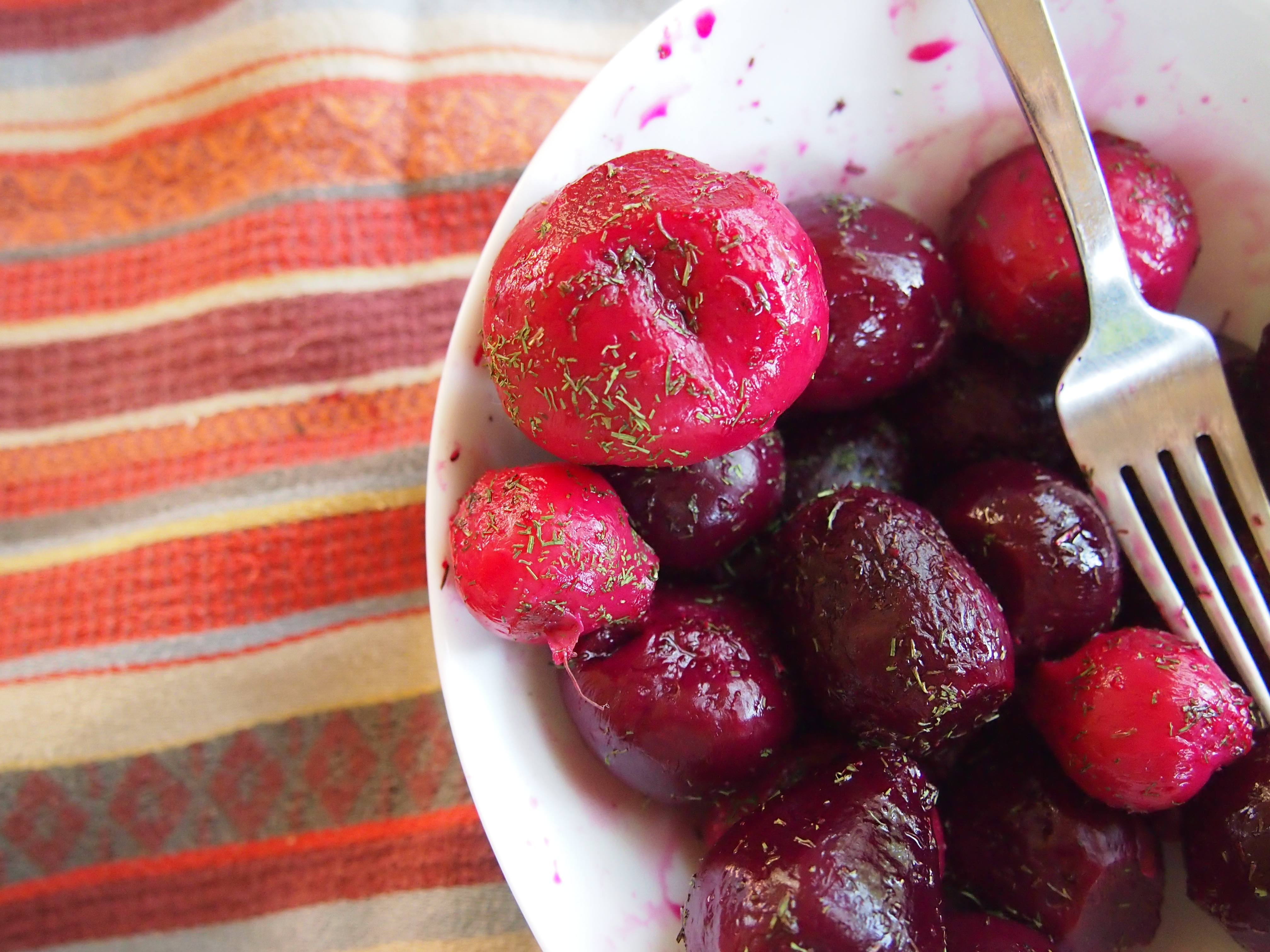
I almost feel unethical posting this as a “recipe.” It’s so simple– a boil, a sprinkle, and done. It came about mostly in an effort to clean out my fridge and spice cupboard. And yet, the result of said kitchen tidying had the added bonus of this stunning salad. (Is it a salad all on it’s own? Or would one need to add lettuce for that? I never know.) The delicate dill rounds off the somewhat bawdy beets. The resulting dish encompasses the best aspects of farm-to-plate eating– earthy richness and heavenly crispness.
Because beets are the main ingredient here, make sure you use the freshest beets you can find. Old ones that have been lolling around shelves for a few weeks tend to be woody at best and bitter at worst. A good beet should be as sweet and firm as a good kiss. To assess the freshness of your beets, squeeze them. They should not be in any way squishy. You can also make sure the greens are crisp and lively, not wilted and listless. Like most vegetables, your best bet is to buy your beets from the person who grew them.
A bonus of finding a local source of beets is that you’re more likely to encounter different varieties. I used the two kinds that City Roots is growing: Bull’s Blood, a deeply red beet, and Chioggia, an heirloom beet with beautiful fuchsia and white rings. (Tragically, these fade when cooked.) While I can’t say they taste much different, they do vary dramatically in color and make a very pretty salad when tossed together.
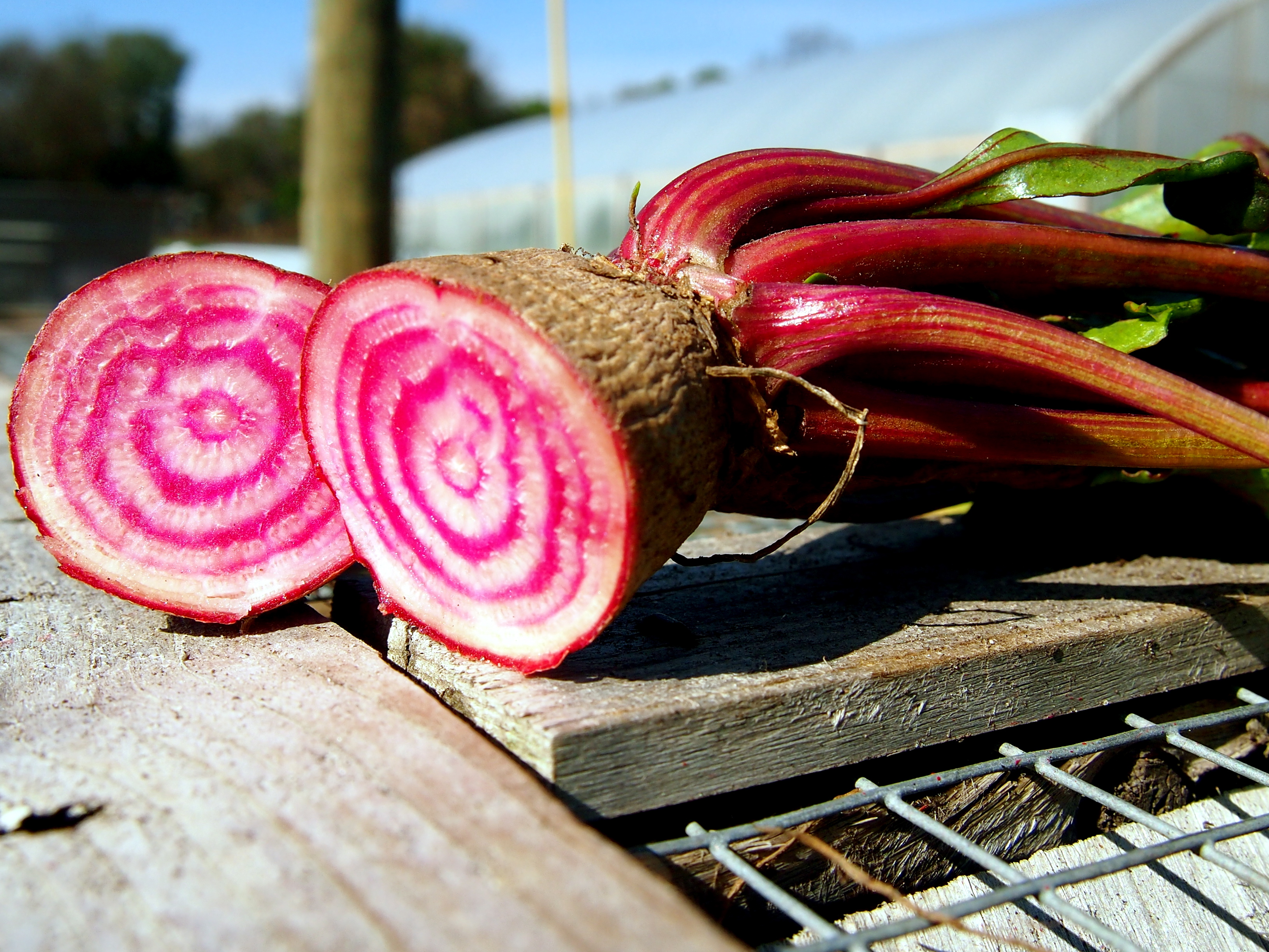
Wherever you get your beets from, make sure you store them properly once you get them home. (Hint: cut those tops off!)
And, out of neighborly concern, I do feel the need to assure you that, the morning after eating this, don’t worry. You’re not dying. You know how people used to dye things with beet juice? Yeah, that’s what happened to your insides. All’s well.
Beets with Dill and Sea Salt
10-12 small (golf ball size) or 2-4 large beets (baseball size)
2 Tbs extra virgin olive oil
2 Tbs fresh or 1 Tbs dried dill
1 tsp sea salt (this is a nice time to break out any special culinary salts you might be harboring)
Rinse off any dirt from your beets, then cut the tops and tails off. If you are using small beets, you may leave them whole. If you are using large beets, cut them into quarters. Put them in a small pot and cover with water. Bring to a boil and simmer for 10 minutes. Let cool. Dump them in a colander and rub off their skins under warm water. Place the beets in a bowl, toss with olive oil and stir in dill and salt. Serve cold or at room temperature; alone or on a bed of greens.

Posted 13 years, 4 months ago at 9:03 pm. Add a comment
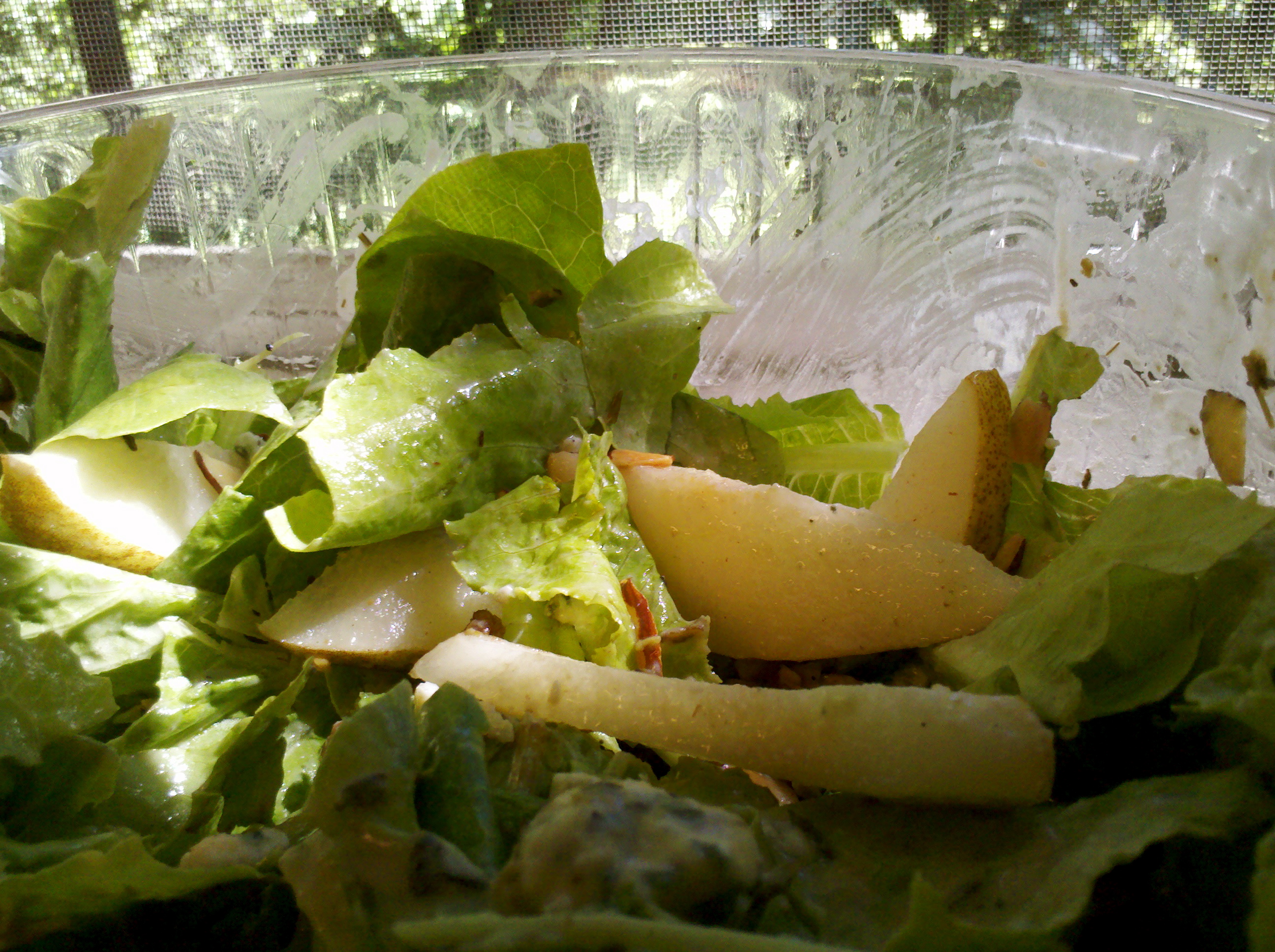 I admire people who can “do” impromptu, whether acting, singing, joke telling, or speeching. For me to agree to do any of those things I would require ample amount of time to prepare. (And even then, you probably only have a hope of convincing me to speak publicly.) Thinking on my feet is not one of my stronger qualities.
I admire people who can “do” impromptu, whether acting, singing, joke telling, or speeching. For me to agree to do any of those things I would require ample amount of time to prepare. (And even then, you probably only have a hope of convincing me to speak publicly.) Thinking on my feet is not one of my stronger qualities.
In the kitchen, however, I am much more adept at improvising. I love the magic of off-the-cuff meals– when disparate ingredients come together into a delicious punchline of a dinner.
That’s what happened this past lunchtime. I gathered together what sounded good: lettuce with the crispness of fall morning air, golden raisins the color of its afternoon light, and toasted almonds smelling of its evening fire. Toothsome pears and leftover pear brandy cream sauce completed the cast.
Posted 13 years, 8 months ago at 7:35 pm. Add a comment
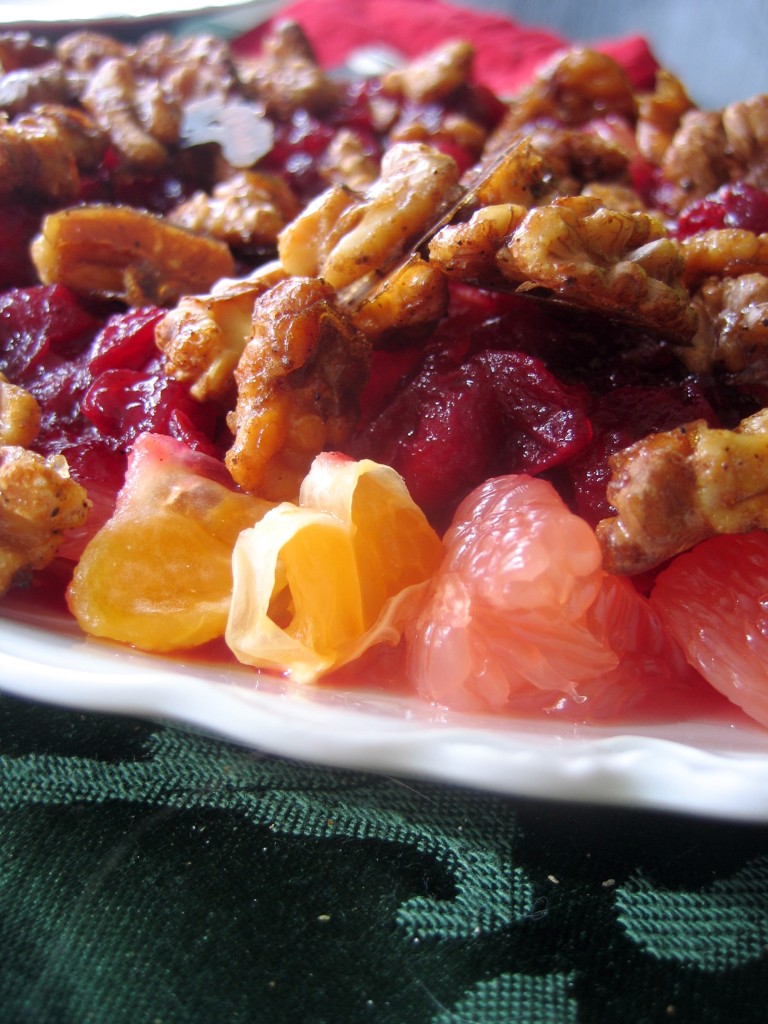 I love citrus. While most cookbooks and online recipe forums seem to think that citrus is best enjoyed in the dog days of summer, I love that it’s true season is actually the mid- winter months. Like a doting grandmother who slips you a bright little foil wrapped piece of candy in that long half hour before dinner, citrus waits till the dark days of winter to ripen.
I love citrus. While most cookbooks and online recipe forums seem to think that citrus is best enjoyed in the dog days of summer, I love that it’s true season is actually the mid- winter months. Like a doting grandmother who slips you a bright little foil wrapped piece of candy in that long half hour before dinner, citrus waits till the dark days of winter to ripen.
While it’s true that citrus isn’t necessarily local, unless you happen to live in Florida, California, or parts of Texas, it is a seasonal fruit, just like anything else. So, while most of us can’t buy citrus from one of our farmer friends, it is still possible to buy it at the peak of its season when it’s freshest, imported the least number of miles, and most importantly– tastiest. For me, that means taking advantage of the natural down time that winter gives us and chowing down on all the grapefruits, tangerines, oranges, clementines, lemons, limes, pomelos, and tangelos I can eat. Peggy Bourjaily wrote an excellent piece for NPR’s Kitchen Window series about this practical locavorism.
Citrus in winter is also a nostalgic thing for me. Truth be told, I would probably eat it in the winter even if it wasn’t in season then. (Conveniently enough though, I get to keep my moral high ground.) As kids, we would always get an orange in the toe of our stocking at Christmas. I don’t know how often we actually ate the orange, but it was of utmost importance that it was there. Since starting our own Christmas traditions, Mr. Quotidian and I have dispensed with the usual stockings filled with odds and ends that end up getting lost or broken in a few weeks. Instead, we leave a pad of paper and pencil by the stockings and write down memories of the other person, then put the memory in the other’s stocking. So, by Christmas morning, we have stockings stuffed with memories. I love the tradition, but obviously an orange would feel rather out of place in such a situation. However, a Christmas without citrus seemed hollow and dull. I realized the easiest way to solve the situation was to serve citrus at one of our Christmas meals. Since citrus doesn’t do well with a cheese fondue, Christmas Eve was out. However, when I remembered a recipe for a salad using oranges and cranberries, Christmas brunch seemed the ideal way to include this jolly, festive fruit. New Year’s brunch would be delicious too…paired with a mimosa perhaps? Continue Reading…
Posted 14 years, 5 months ago at 6:52 pm. 1 comment
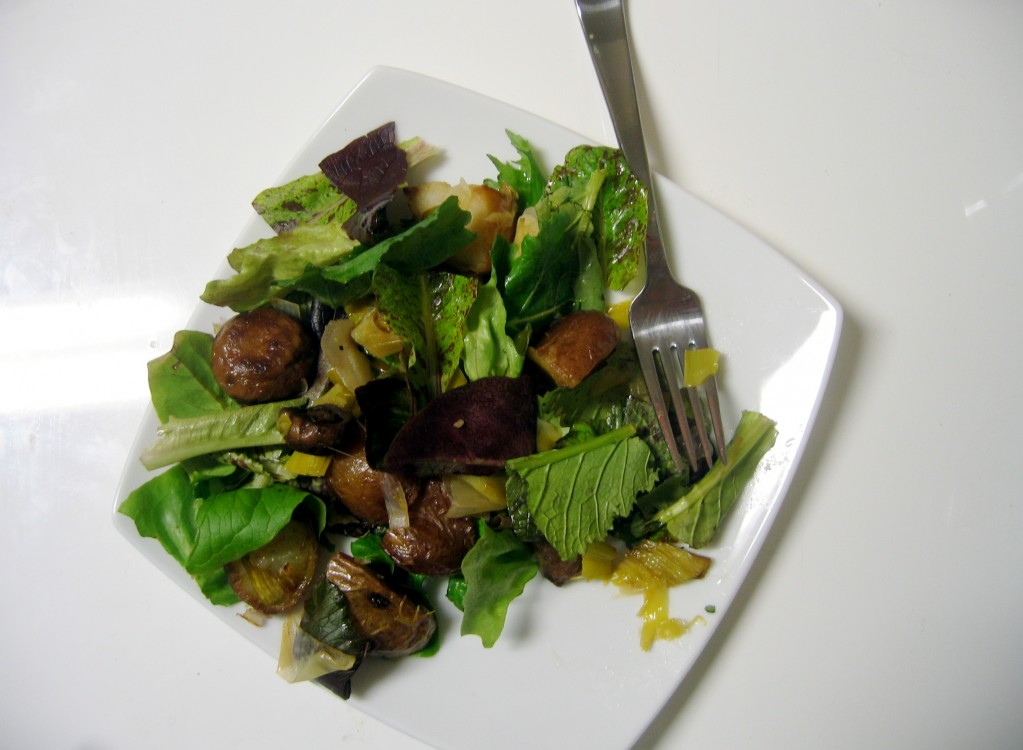
When I was making my menu a few days ago, it was cold and blustery outside. I also had some potatoes that needed to be used. Destiny seemed to be handing me a steaming bowl of Potato and Leek Soup.
But wait, this is Southern Destiny. And what’s that she’s wearing? Short sleeves and sandals? By the time Potato and Leek Soup night rolled around, it was a balmy 70°. I took the potatoes and leeks from Destiny’s hands, but left the soup for another day. Continue Reading…
Posted 15 years, 4 months ago at 6:32 am. 4 comments







